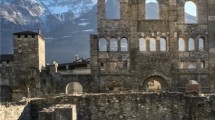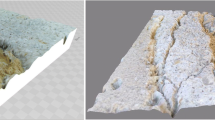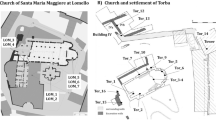Abstract
The mineralogical characterisation of historic mortars is performed for a number of reasons related to the conservation of traditional structures. The reasons for analysis and the questions posed during the conservation, repair or restoration of an old building determine the analysis methods that will be chosen. A range of mineralogical characterisation methods is available for the study of historic masonry mortars. These include X-ray Diffraction (XRD), Optical Microscopy, Scanning Electron Microscopy (SEM), Thermal and Infra-Red methods. Sample preparation is important; adequate separation of binder from aggregate is required for instrumental as opposed to microscopic investigation methods. An ordered scheme of analysis can be developed and is presented in flowchart form. It is difficult, and perhaps unwise, to analyse a mortar with only one method of characterisation. Corroboration of evidence of identification and quantification for mineralogical composition is best supported by a combination of methods, including chemical analysis methods. All methods of characterisation require qualified and experienced people to cary out the analyses.
Résumé
La caractérisation minéralogique des mortiers historiques est exécutée pour des raisons différentes qui sont liées à la conservation des constructions traditionnelles. Les raisons de l’analyse et les questions posées lors de la conservation, la réparation ou la restauration d’une construction historique déterminent les méthodes d’analyse choisies. Une gamme de méthodes de caractérisation minéralogique est disponible pour l’étude des mortiers historiques de maçonnerie. Celles-ci comprennent la diffractométrie par rayon X (DRX), la microscopie optique, la microscopie électronique de balayage (MEB), les méthodes thermiques et infrarouge. La préparation de l’échantillon est importante: la séparation adéquate du liant et du granulat est obligatoire pour des méthodes instrumentales (comme les analyses chimiques), ce qui n’est pas le cas pour les méthodes d’investigation microscopiques. Il est difficile, et peut-être peu judicieux, d’analyser un mortier avec une seule méthode de caractérisation. Un schéma systématique relatif aux analyses à exécuter peut être développé et est présenté sous forme d’organigramme. Toutes les méthodes de caractérisation exigent du personnel qualifié et expérimenté pour exécuter les analyses.
Similar content being viewed by others
References
Knöfel, D. and Schubert, P. Handbuch, P., ‘Handbook, Mortars and Stone Replacement Materials in Restoration’ (Ernst & Sohn, Berlin, 1993) [in German].
Middendorf, B., ‘Characterisation of historic mortars from brick masonry and development of water resistant mortars based on gypsum’, unpublished PhD-thesis, University Siegen, Germany, 1994 [in German].
Gödicke-Dettmering, T. and Strübel, G., ‘Mineralogical and technological properties of hydraulic lime as binder for mortars in restoration’,Giessener Geologische Schriften 56 (1996) 131–154 [in German].
Callebaut, K., Elsen, J., Van Balen, K. and Viaene, W., ‘19th century hydraulic restoration mortars in the Saint-Michael’s church (Leuven, Belgium): natural hydraulic lime or cement?’,Cement and Concrete Research 31(3) (2001) 397–403.
Wisser, S. and Knöfel, D., ‘Analyses of historic plaster and mortar, Part I: Analytical methods’,Bautenschutz+ Bausanierung 10 (1987) 124–126 [in German].
Wisser, S. and Knöfel, D., ‘see [5], Part II: Analyses and results’,Bautenschutz +Bausanierung 11 (1988): 163–171 [in German].
Wisser, S., ‘Historic and modern mortars connected with natural stones: chemical, mineralogical and technological properties’ (Freiburg, Breisgau, 1989) [in German].
Duttlinger, W., ‘Deterioration of natural stones caused by salts: Analyses of buildings and comparable results of field studies’, unpublished PhD-thesis, University Freiburg, Germany, 1990) [in German].
Papayianni, I., ‘Technology of mortars and bricks used in Ottoman monuments of Thessaloniki’, in Int. Conf. on Studies in Ancient Structures, Istanbul, 1997, 245–258.
Middendorf, B. and Knöfel, D., ‘Characterisation of historic mortars from secular and religious buildings in Germany and the Netherlands’, in ‘Conservation of Historic Brick Structures: Case Studies and Reports of Research’, Editors: N.S. Baeret al. (Donhead Publishing Ltd, England, 1998) ISBN 1 873394 34 9.
Middendorf, B. and Knöfel, D., ‘Gypsum and lime mortars of historic German brick buildings: analytical results as well as requirements for adapted restoration material’, in ‘Conservation of Historic Brick Structures: Case Studies and Reports of Research’, Editors: N.S. Baeret al. (Donhead Publishing Ltd, England, 1998) ISBN 1 873394 34 9.
Callebaut, K., ‘Characterisation of historical lime mortars in Belgium: implications for restoration mortars’ (Unpublished PhD-thesis, K.U. Leuven, 2000).
Furlan, V. and Pancella, R., ‘Examen microscopique en lumière réfléchie de ciments, bétons et mortiers’,Chantiers/Suisse 13 (1982) 25–30.
St. John, D.A., Poole, A.B. and Sims, I., ‘Concrete Petrography. A handbook of investigative techniques’ (Arnold Publishers, London, 1998) 127–133.
Callebaut, K., Viaene, W., Van Balen, K. and Ottenburgs, R., ‘Petrographical, mineralogical and chemical investigation of 17th and 19th century lime mortars in the St.-Michael’s church (Leuven, Belgium)’,Internationale Zeitschrift für Bauinstandsetzungen und Denkmalpflege 5 (4) (1999) 523–542.
Bakolas, A., Biscontin, G., Moropoulou, A. and Zendri, E., ‘Characterization of the lumps in the mortars of historic masonry’,Thermochimica Acta 269/270 (1995) 809–816
Lindqvist, J.E. and Sandström, M., ‘Recommendations of RILEM TC 167-COM: Characterization of old mortars— Quantitative analysis of historical mortars using optical microscopy’,Mater. Struct. 33 (2000) 612–617.
Recommendations of RILEM TC 167-COM: ‘Characterization of old mortars’—COM-C1: Assessment of mix proportions in historical mortars using quantitative optical microscopy,Mater. Struct. 34 (2001) 387–388.
Larbi, J.A. and van Hees, R.P.J., ‘Quantitative microscopical procedure for characterisation mortars in historical buildings’, Proceedings 14 (Internationale Baustofftagung, ibausil, Weimar, 2000) 1.1051–1.1060.
Stefanidou, M., ‘Estimation of porosity by using different techniques’, 8th Euroseminar on Microscopy Applied to Building Materials, Athens (2001) 619–624.
Diamond, S., ‘Identification of hydrated cement constituents using a scanning electron microscope—energy dispersive X-ray spectrometer combination’,Cement and Concrete Research 2 (1972) 617–632.
Lewin, S.Z., ‘X-ray diffraction and scanning electron microscope analysis of conventional mortars’, in ‘Mortars, Cements and Grouts Used in the Conservation of Historic Buildings’, Symposium, Rome, ICCROM (1981) 101–132.
Middendorf, B., Böttger, K.G. and Knöfel, D., ‘SEM-analyses of influences of different retarders and additives on the binder hardening of cement- and gypsum mortars’,Beitr. Elektronenmikroskop. Direktabb. Oberfl. 25 (1992) 215–222 [in German].
Adams, J.E.A. and Kneller, W.A., ‘Thermal analysis (TA) of medieval mortars from Gothic cathedrals of France’, in the proceedings of ‘The Engineering Geology of Ancient Works, Monuments and Historical Sites-Preservation and Protection’, Athens Greece, September 1988, P.G. Marinos and G.C. Koukis, eds. (A.A. Balkema, publisher, Rotterdam, The Netherlands, 1988) 1019–1026.
Moropouloou, A., Bakolas, A. and Bisbikou, K., ‘Characterisation of ancient, Byzantine and later historic mortars by thermal and x-ray diffraction techniques’,Thermochimica Acta 269/270 (1995) 779–795.
Willard, H.H.et al., ‘Instrumental Methods of Analysis’ (Litton Educational Publishing, California, USA, 1981).
Newton, R.G. and Sharp, J.H., ‘An investigation of the chemical constituents of some renaissance plasters’,Studies in Conservation 32 (1987) 163–175.
Ellis, P.R., ‘Analysis of mortars by differential thermal analysis’, in ‘Historic Mortars: Characteristics and Tests’, Bartos, P., Groot, C. and Hughes, J.J. (eds.), RILEM International Workshop, Paisley, PRO 12 (RILEM Publications, France, 2000) 133–147.
Paama, L., Pitkänen, I., Rönkkömäki, H. and Permamäki, P., ‘Thermal and infrared spectroscopic characterization of historical mortars’,Thermochimica Acta 320 (1998)
Taylor, H.F.W., ‘Cement Chemistry’, 2nd Edition (Thomas Telford Publishing, London, 1997).
Moropouloou, A., Bakolas, A., Michailidis, P., Chronopoulos, M. and Spanos, Ch., ‘Traditional technologies in Crete providing mortars with effective mechanical properties’,Structural Studies of Historical Buildings Traditional Technologies 1 (50) (1995) 151–161.
Moropoulou, A., Bakolas, A., Moundoulas, P. and Camak, A.S., ‘Compatible restoration mortars for Hagia Sophia earthquake protection’, Earthquake Resistant Engineering Structures, Compatible Restoration, Ch. 78 (1999) 522–531.
Moropoulou, A., Bakolas, A. and Bisbikou, K., ‘Investigation of the technology of historic mortars’,Journal of Cultural Heritage 1 (2000) 45–58.
Moropoulou, A., Bakolas, A. and Bisbikou, K., ‘Physicochemical adhesion and cohesion bonds in joint mortars imparting durability to the historic structures’,Construction and Building Materials 14 (2000) 35–46.
Bakolas, A., Biscontin, G., Contardi, V., Franceschi, E., Moropoulou, A., Palazzi, D. and Zendri, E., ‘Thermoanalytical research on traditional mortars from Venice’,Thermochimica Acta 269/270 (1995b) 817–828.
Bakolas, A., Biscontin, G., Moropoulou, A. and Zendri, E., ‘Characterization of structural Byzantine mortars by thermogravimetric analysis’,Thermochimica Acta 321 (1998) 151–160.
Hakanen, E. and Koskikallio, J., ‘Analysis of aragonite and calcite in precipitated calcium carbonate by x-ray diffraction and infrared spectroscopic methods’,Finn. Chem. Lett, Pt 3–4 (1982) 34–37.
Featherstone, J.D.B., Pearson, S. and Le Geros, R.Z., ‘An infrared method for quantification of carbonate in carbonated apatites’,Caries Research 18 (1984) 63–66.
Bruni, S., Cariati, F., Fermo, P., Pozzi, A. and Toniolo, L., ‘Characterization of ancient magnesian mortars coming from northern Italy’,Thermochimica Acta 321 (1998) 161–165.
Luxán, M.P., Dorrego, F. and Laborde, A. ‘Ancient gypsum mortars from St. Engracia (Zaragoza, Spain): Characterization. Identification of additives and treatments’,Cement and Concrete Research 25 (8) (1995) 1755–1765.
Doménech Carbó, M.T., Bosch Reig, F., Gimeno Adelantado, J.V. and Periz Martínez, V., ‘Fourier transform infrared spectroscopy and the analytical study of works of art for purposes of diagnosis and conservation’,Analytica Chimica Acta 330 (1996) 207–215.
Author information
Authors and Affiliations
Additional information
TC Membership—Chairman: Caspar Groot, The Netherlands;Secretary: Geoff Ashall, United Kingdom;Members: Giulia Baronio, Italy, Peter Bartos, United Kingdom; Luigia Binda, Italy; Jan Elsen, Belgium; John Hughes, United Kingdom; Jan Erik Lindqvist, Sweden; Paul Maurenbrecher, Canada; Ioanna Papayianni, Greece; Margaret Thomson, USA; Koen Van Balen, Belgium; Rob Van Hees, The Netherlands; AlfWaldum, Norway.
Rights and permissions
About this article
Cite this article
Middendorf, B., Hughes, J.J., Callebaut, K. et al. Investigative methods for the characterisation of historic mortars—Part 1: Mineralogical characterisation. Mat. Struct. 38, 761–769 (2005). https://doi.org/10.1007/BF02479289
Issue Date:
DOI: https://doi.org/10.1007/BF02479289




